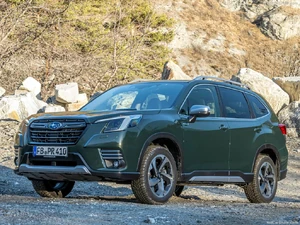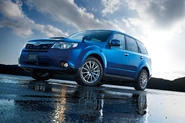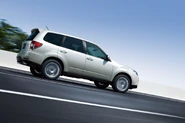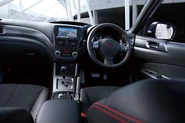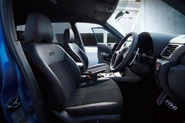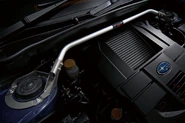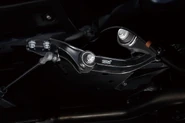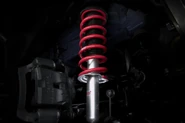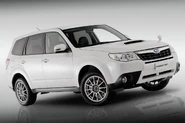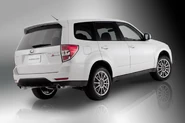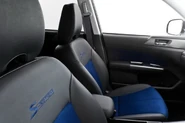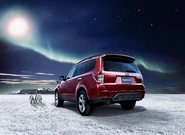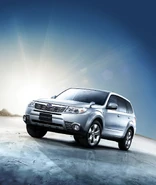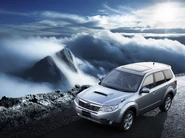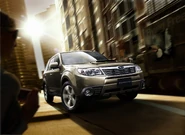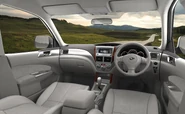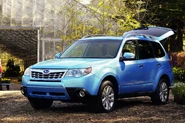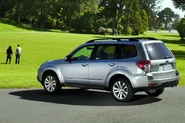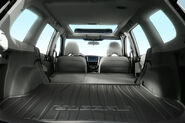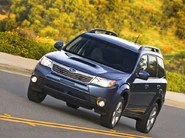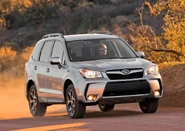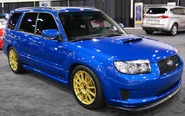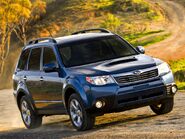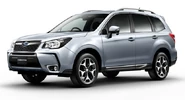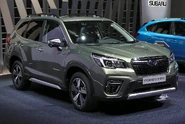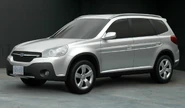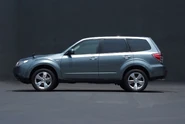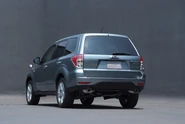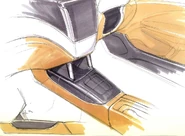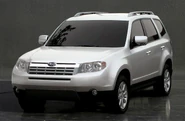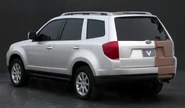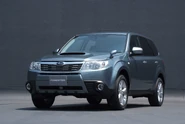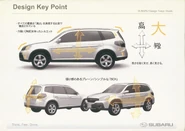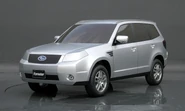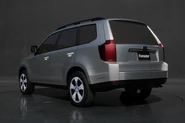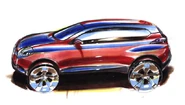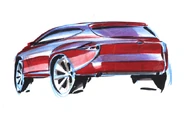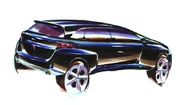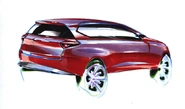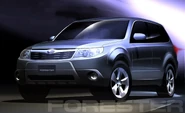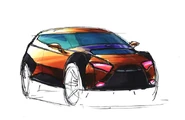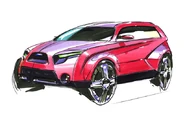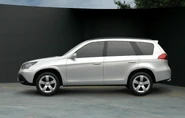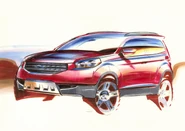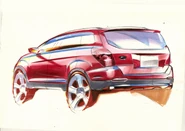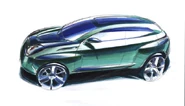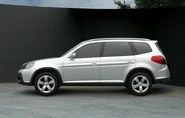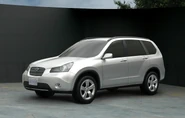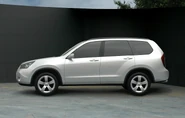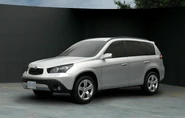The Subaru Forester (Japanese: スバル•フォレスター Subaru Foresutā) is a Wagon / compact crossover SUV (sport utility vehicle) that has been manufactured since 1997 by Subaru. Available in Japan from 1997, the Forester shares its platform with the Impreza. The current Forester has 6 trims: Standard, Premium, Sport, Limited, Wilderness, and Touring. The Touring has features like brown leather seats, heated seats, navigation, and a panoramic sunroof. All-wheel drive is standard on every trim level.
See Autopedia's comprehensive Subaru Forester Review.
Recent Changes[]
- For 2011, Subaru launched the JDM-only Forester tS. Based on the Forester S-Edition, the tS has been upgraded with a raft of STi parts including a modified suspension that sits 15 mm lower than usual, 17-inch alloys, a front spoiler and the customary tS logos. Inside there are STI sport seats wrapped in a combination of leather and Alcantara as well as a sports steering wheel and a modified instrument panel. Japanese customers will get to choose between four exterior colors and will have to pay 3,450,00 Yen (US $42,227 or €30,646) for the base model. Subaru said it plans to produce a total of 300 examples of the Forester tS. [1]
- Australia's best-selling compact sports utility vehicle, the Symmetrical All-Wheel Drive Subaru Forester, offers a new range-topping turbocharged variant for 2011 and refined, torque-enhanced new naturally aspirated engine. The S-Edition is the most powerful Forester to date, using the legendary WRX's turbocharged 2.5 litre to produce 193 Kilowatts of power and 347 Newtonmetres of torque. It offers improved low-end torque, increased by six Newtonmetres to 235 Nm at 4100 rpm, while refinement, NVH and drivability are also greatly enhanced. The engine will become the platform for a range of refinements throughout the Subaru range over the next few years. Emissions of the automatic transmission NA engine are reduced from 227 grams per kilometres to 220 g/km[2]
- For the 2009 model year, the Subaru Forester is an all-new generation. Officially unveiled at the end of 2007, the new third-generation Forester rides on an all-new platform featuring a 3.6-inch longer wheelbase (103.0 in) equipped with Symmetrical All-Wheel Drive (as standard) driven by a choice of a naturally aspirated and turbocharged / intercooled 2.5-liter Boxer engines. The Forester will be on sale in the US market by spring 2008. The new car was designed under Osamu Namba.[1][2]
- Several elements of the Forester were redesigned for 2006, including the headlights, taillights, grill and dashboard. In addition, its 2.5L engine was boosted from 165hp to 173hp and its turbocharged engine has increased from 210hp to 230hp. In addition, one of its trim lines, the XS, has been removed from production.
Styles and Major Options[]
For 2009, the Subaru Forester is available in four trims: the Forester 2.5 X, Forester 2.5 X Limited, Forester 2.5 XT, and Forester 2.5 XT Limited. All trims come equipped with Subaru's standard Symmetrical All Wheel Drive. Forester 2.5 X models are powered by a 2.5-liter flat-4 producing 170 hp @ 6,000 rpm and 170 lb-ft of torque @ 4,400 rpm.[3]
Pricing[]
Today's actual prices for the Subaru Forester can be found at CarsDirect.
|
Forester Trims | |||
|
2.5 X |
2.5 X Limited |
2.5 XT |
2.5 XT Limited |
|
MSRP |
|||
|
$19,995 |
$25,995 |
$26,195 |
$28,195 |
|
Invoice |
|||
|
$18,913 |
$24,330 |
$24,557 |
$26,384 |
Gas Mileage[]
As seen on the FuelEconomy.gov website, the City/Highway MPG averages are as follows:
|
Trim | |
|
2.5L |
2.5L Turbo |
|
MPG |
|
|
20/26 |
19/24 |
Reliability[]
While there have been complaints of transmission problems with vehicles with the turbo/5-speed combination, most have been fairly reliable. Interior build quality has been known to show wear early on, with Car and Driver's long term test car showing premature interior wear and squeaks and rattles at 40,000 miles. While the car will appear and sound worn, there will be know repairs needed causing its reliabilty rating to stay high. Long term durability is impeccable, as revealed at www.Edmunds.com, and www.Carsurvey.org
Safety[]
The Forester has received superb marks in crash tests performed by the NHTSA, scoring 5/5 stars in every category but Rollover Rating, for which it earned 4/5 stars. The following safety features are also standard on every trim:
- 4-Wheel Anti-Lock Brakes (ABS)
- Electronic Brake-force Distribution
- Electronic Stability Control
- Daytime Running Lights
- Driver/Passenger Front Airbags
- Seat-Mounted Side Impact Airbags
- Side-curtain Airbags
- Side Impact Bars
Photos[]
Third Generation Development Prototypes
Colors[]
Colors for the Forester can be found at CarsDirect.com.
Main Competitors[]
Hybrid Models[]

Subaru introduced the e-BOXER hybrid powertrain for the European-market Forester and XV at Geneva in March 2019; the e-BOXER integrates an electric motor into the Lineartronic CVT to improve fuel economy and increase power. The e-BOXER powertrain features a modified FB20 rated at 110 kW (148 hp; 150 PS) at 5,600–6,000 rpm and 194 N⋅m (143 lb⋅ft) of torque at 4,000 rpm. Like the first-generation XV Crosstrek Hybrid, the Forester e-BOXER adds a single electric motor rated at 12.3 kW (16.5 hp; 16.7 PS) maximum output. The battery for the traction motor is placed above the rear axle, improving the front/rear weight balance.
Unique Attributes[]
Resale Values[]
Kelley Blue Book estimates that the Forester will have have a better resale value than the Ford Escape or Mazda Tribute, yet still trail behind the Honda CR-V in this category. Automotive Lease Group rates the Forester's resale value at 3 stars out of 5, which is equivelant to a D-.
Criticisms[]
- "...the three rear headrests block your [the driver's rearward] vision." - The Detroit News
- "Because the Forester delivers a choppier ride than some rivals with more vibration, it might not appeal to those who favor an always-gentle road experience." - Kelley Blue Book
- "Refinement is roughly on par with the competitive Ford Escape and Mazda Tribute, but it falls short of Honda's CR-V." - Kelley Blue Book
- "Like the Impreza, it looks somewhat blander than before." - motioncars.com
Generations[]
Fifth generation (SK; 2018)[]
The fifth-generation Forester was revealed on March 28, 2018 at the New York International Auto Show. Like contemporary Subaru models, the fifth-generation model moved the Forester to the Subaru Global Platform. The new platform is said to provide greater handling capability, agility, ride comfort and crash protection. It is also claimed to be inherently resistant to noise, vibration and harshness (NVH).
While sporting design cues from the previous generation, the fifth-generation Forester incorporates Subaru’s "Dynamic x Solid" recent design language. Interior space has been increased with the redesign, by lengthening the wheelbase by 1.2 in (30 mm) to 105.1 in (2,670 mm). Rear legroom has grown by 1.4 in (35 mm) to 39.4 in (1,000 mm), while head, hip and shoulder room have is also increased, improving the overall cabin space. Wider rear door openings and a steeper C-pillar allow for easier entry and egress and also makes installing a child seat easier.
The reworked front seats are claimed to be more comfortable on long trips. Subaru also included an electric parking brake which frees up center console space. Cargo space in the trunk is larger with 2,155 litres (76.1 cu ft) with the 60:40-split rear seats folded – an increase of 40 litres (1.4 cu ft) – and the maximum width of the tailgate opening is 5.3 in (135 mm) wider at 51.2 in (1,300 mm).
North America[]
Initial trim levels available in the U.S. and Canada are Base, Premium, Sport, Limited and Touring. All Foresters sold in the U.S. come standard with Subaru's Eyesight Driver Assist Technology. Subaru DriverFocus Distraction Mitigation System comes standard on the Touring trim in the U.S., which provides an alert when it detects the driver is distracted or is drowsy. In addition, the DriverFocus system is able to recognize five different drivers and will set seat and mirror positions and climate control settings accordingly.
As standard, the Forester comes with the Starlink Multimedia system with a 6.5-inch touchscreen.
In North America, the model is only available with one engine type: Subaru's new FB25 DI. The engine is a naturally aspirated, direct injection flat (boxer) 4 cylinder producing 182 hp (136 kW; 185 PS) at 5800 rpm and 176 lb⋅ft (239 N⋅m; 24 kg⋅m) at 4400 rpm, with the Lineartronic CVT as the sole transmission option.
All fifth-generation Foresters have one of three versions of Subaru's Symmetrical All Wheel Drive system. The trim levels in North America determines which system is installed. The Base trim received a Variable Torque Distribution (VTD) using electronically controlled clutches to control torque split. Premium, Sport, Limited and Touring trims receive the driver-selectable X-Mode system with Hill Descent Control, which optimises engine, transmission, AWD system and Vehicle Dynamics Control for maximum traction on slippery conditions. A new dual-mode version with Snow/Dirt and Deep Snow/Mud modes is fitted on Sport, Limited and Touring variants. All models provide a nominal torque split biased 60 front to 40 rear.
Forester e-Boxer[]
Subaru introduced the e-Boxer hybrid powertrain for the European-market Forester and XV at the Geneva Motor Show in March 2019; the e-Boxer integrates an electric motor into the Lineartronic CVT to improve fuel economy and increase power.
The e-Boxer powertrain features a modified FB20 rated at 110 kW (148 hp; 150 PS) at 5,600–6,000 rpm and 194 N⋅m (143 lb⋅ft; 20 kg⋅m) of torque at 4,000 rpm. Like the first-generation XV Crosstrek Hybrid, the Forester e-Boxer adds a single electric motor rated at 12.3 kW (16 hp; 17 PS) maximum output. The battery for the traction motor is placed above the rear axle, improving the front/rear weight balance.
Facelift[]
The facelifted model was released for North America in September 2021 for the 2022 model year. It had a new front end as well as a slightly tweaked rear bumper while the powertrain was unchanged. All Forester models have Subaru's updated fourth-generation eyesight driver-assist system. An off-road-focused Wilderness model was also introduced.
Forester Wilderness[]
Alongside the facelift model, Subaru released a new model called the Forester Wilderness for the North American market. It is intended to be a more off-road-oriented version of the Forester, and is positioned between the Limited and Touring trim levels in the Forester lineup. Visually, the Forester has more body cladding, and on the inside, copper-colored accents. It features a 0.5 inches (13 mm) lift for a total of 9.2 inches (230 mm) of ground clearance, the Wilderness also has all-terrain tires, a modified final drive ratio, and a stronger roof rack than previous models. Subaru's StarTex water-repellent seats are also standard.
The Wilderness is powered by the same 2.5-liter FB25D naturally-aspirated four cylinder engine powering other North American market Foresters. The Wilderness uses an Enhanced Dual-Function X-Mode version. The X-Mode is upgraded and re-tuned, with settings for snow, dirt, deep snow and mud. Additional wheel-slip is allowed to occur, which provides an advantage in harsh driving conditions.
Fourth generation (SJ; 2012)[]
The fourth-generation Forester was unveiled in the 2012 Guangzhou Motor Show, followed by the 2013 New York International Auto Show.
Japan models went on sale in November 2012. Early model includes 2.0i, 2.0i-L, 2.0i-L EyeSight, 2.0i-S EyeSight, 2.0XT (280 PS), 2.0XT EyeSight (280 PS). 2.0i engine models include six-speed manual (2.0i, 2.0i-L) or Lineartronic CVT transmission; 2.0XT (280 PS) engine models include Lineartronic CVT transmission.
US models went on sale in March 2013 as 2014 model year vehicles. Early models include 2.5i in base, Premium, Limited and top-line Touring versions, and performance-oriented turbocharged 2.0XT (253 PS) in Premium and Touring versions. Base and Premium model 2014 Foresters can be equipped with the manual six-speed transmission or the Lineartronic CVT. All other models are equipped with the Lineartronic CVT.
An option on Limited/Touring 2.5i and Premium/Touring 2.0XT is new X-Mode control and Hill Descent Control (HDC) features. These are not available on other models.
The 2014 Forester has a new feature called X Mode that allows owners to go through more extreme conditions both on the road and off. The concept is that any driver, regardless of skill level, can drive safely on wet roads or muddy areas. It works by monitoring wheel-slip on all four wheels; should one or more wheels begin to slip, X Mode kicks in and applies the brakes to the affected wheel which results in a transfer of power to the opposite wheel. After it is engaged by a simple push button, X Mode stays engaged up until the vehicle's speed is about 25 mph (40 km/h) then disengages itself.
Facelift[]
The facelifted fourth-generation Forester was revealed in October 2015 ahead of the 2015 Tokyo Motor Show. Changes include new LED projector headlights with C-shaped positioning lights, new taillights, a redesigned grille and a reprofiled front bumper.
Subaru also introduced improvements to the Forester’s AWD chassis and NVH. It also feature greater front cross member rigidity and optimisation of the rear trailing link bushings which result in better steering response and straight-line stability. The turbo model gets Active Torque Vectoring. Ride comfort has been improved with optimised dampers and spring rates, while thicker door glass, stronger sealing, additional under-floor insulation and improvements to the Lineartronic CVT gearbox result in quieter ride. The FB 2.0-liter naturally-aspirated flat-four petrol engine with 148 PS (109 kW; 146 hp) has been given more efficient combustion and reduced friction for better fuel efficiency with no loss of performance.
The Forester uses color cameras for the EyeSight system with a wider and longer field of view. Alongside EyeSight which was upgraded to Version 3, Subaru offered a Rear Vehicle Detection package that includes Blind Spot Detection, Lane Change Assist and Rear Cross Traffic Alert. The stereo cameras of Eyesight also double up as the eyes for Adaptive Driving Beam.
Third generation (SH; 2009)[]
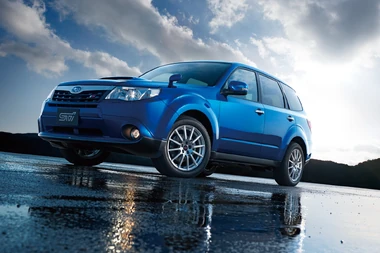
The JDM-Only Subaru Forester tS
The third-generation Forester began to move away from a traditional wagon design towards becoming a crossover SUV. It was larger in nearly every dimension and featured a sloping roofline with more cargo space. Subaru unveiled the model year 2008 Forester in Japan on December 25, 2007. The North American version made its debut at the 2008 North American International Auto Show in Detroit.
Styling was by Subaru Chief Designer Mamoru Ishii. The dimensions derive from engineers using the basic body structure of the Japanese-spec Impreza wagon with the rear platform of the U.S.-spec Impreza sedan. The Forester's wheelbase was increased 3.5 inches (89 mm), with overall increases of 3.0 inches (76 mm) in length, 1.8 inches (46 mm) in width and 4.3 inches (110 mm) in height.
The independent double-wishbone rear suspension was redesigned for better handling and a smoother ride. A "Sportshift" mode was added to the four-speed computer-controlled automatic transmission. The in-dash, touch-screen satellite navigation system became Bluetooth compatible, and integrated with a premium stereo. A six-speaker surround sound enhancement was optional.
The new model added 3.5 inches (89 mm) to the Forester's wheelbase, improving interior space and cargo room (31 cu ft (0.88 m3) expandable to 69 cu ft (2.0 m3)). Ground clearance was 8.9 inches (230 mm).
Markets[]
Europe[]
The Forester was available in Europe from 2008 with either the 2.0-liter EJ20 (150 hp; 110 kW) 196 Nm gasoline engine with Active Valve Control System (AVCS) matched to either five-speed manual or four-speed automatic gearbox, or an all-new diesel-powered horizontally opposed Subaru EE boxer engine, and six-speed manual gearbox. The new model was introduced at the 2008 Paris Motor Show in October.[17] The diesel engine produces a power output of 147 PS (108 kW; 145 hp) and 350 Nm. The EE20 diesel engine in the Euro 4 guise was plagued by crankshaft failure caused by cracks forming when operated in cold climate. Although Subaru never acknowledged this defect, the engine was reworked for the Euro 5 model in 2011 to eliminate this issue.
In the UK, the gasoline-powered Forester was offered in the popular X and XS models, while the trim levels for the diesel models were X, XC, and XS NavPlus.
In the Netherlands, the Forester is offered with gasoline or diesel engines. The gasoline engine can also be fitted with an additional liquefied petroleum gas installation (LPG), an aftermarket installation provided directly through dealerships. The available equipment levels are Intro (gasoline engine only), Comfort, Luxury, Premium, and XT (gasoline engine turbo). Maximum towing abilities for the gasoline or gasoline with LPG are 2000 kg (manual) or 1500 kg (auto), while the manual-only diesel can tow 2000 kg.
United States[]
The Forester trim levels were the 2.5X Limited, the 2.5X Premium, the 2.5X and the 2.5XT Limited and 2.5XT Premium both with turbo. The interior color was either black or light gray, with three upholstery selections, including leather.[22] Nine exterior colors were offered, with four colors in a pearlescent appearance.
Starting July 2009, Subaru no longer offered a special-edition L.L. Bean trim level on the Forester.[23] The Subaru Elaion is a modified Subaru Forester which was built by Subaru and Elaion (Repsol-YPF).
The USA 2.5X model was certified PZEV emissions (Rated 175 hp (130.5 kW) instead 170 hp (126.8 kW)), with a badge attached to the rear of the vehicle on the bottom right-hand side of the tailgate. All other USA models were certified LEV2. The PZEV Forester was available for sale in all fifty states, unlike other manufacturers who only sold PZEV-certified vehicles in states that had adopted California emission standards. The engine without the turbo runs on unleaded gasoline rated at 87 octane, and the turbo engine (EJ255) requires premium fuel rated minimum 91 octane.
Safety equipment included front airbags with side curtain airbags and front passenger-side airbags (for a total of six airbags) and brake assist that detects panic-braking situations and applies maximum braking force more quickly. The five-speed manual transmission was equipped with Incline Start Assist.
Some of the standard equipment found on the 2.5X included Subaru's VDC (Vehicle Dynamics Control), 16 inch steel wheels, and an auxiliary audio jack for MP3 players. Optional equipment included 17 inch alloy wheels, panoramic moonroof, heated front seats, and heated side-view mirrors. The L.L. Bean edition added automatic climate control, leather upholstery, an upgraded stereo with six speakers and a six-disc in-dash CD changer over the four-speaker stereo with single-disc CD player, and an in-dash navigation system, as well as L.L. Bean signature floor mats and rear cargo tray.
The 2.5 XT came with the premium stereo standard, as well as 17-inch alloy wheels, and the panoramic moonroof. The 2.5 XT Limited added leather upholstery with heated front seats, in-dash navigation, a rear spoiler, and automatic climate control. For 2009, XT models came only with a four-speed automatic with Sport Shift.
Facelift[]
In 2010 (U.S. model year 2011), the Subaru Forester received a minor facelift featuring a new grille insert and several small changes in various trim levels. A new 2.5X Touring trim level was also introduced above the 2.5X Limited. The 2.5X Touring trim added HID lighting, a rearview camera, dual-zone climate control, and silver roof rails. 2.5XT models got a slightly larger rear roof spoiler.
Subaru also quietly switched to the all-new 2.5L DOHC FB25 third-generation boxer engine in naturally aspirated Forester models. The new engine made the same 170 hp (126.8 kW) as the outgoing EJ253, but torque increased by 4 lb-ft to 174 lb-ft (235.9 N⋅m). Fuel economy improved by 1 mpg EPA city/highway to 21/27. 2.5XT models retained the 2.5L DOHC EJ255 turbo engine.
Second Generation (2003-2008)[]
The second generation was introduced as a 2003 model at the 2002 Chicago Auto Show, based on the new Impreza platform, featuring several fine-tune improvements over the past model. The 2003 Forester features weight-saving refinements such as an aluminum hood, perforated rails, and a hydro-formed front sub-frame. The most noticeable change was the offering of 2.5 L versions (normally aspirated and turbocharged) and in the U.S. the introduction of the turbocharged 2.5-liter model. In the United States, the naturally aspirated X (previously L) and XS (previously S) were released in 2003. In 2004, the turbocharged XT trim was released. However, the same model had been available since the late 1990s elsewhere in the world. The X and XS models feature a 2.5 L SOHC EJ253 engine, while the XT model features a 2.5 L turbocharged DOHC engine. Both engines have timing belt (camshaft). The XT model uses the same Mitsubishi Motors TD04 turbocharger used in the Subaru Impreza WRX. All Forester 2.5 L engines are of the interference engine type. Starting with the 2004 XT, the turbocharged version had Active valve control system cylinder heads. The i-AVLS (active valve lift system) became standard on the naturally aspirated version of the Forester in 2006. This increased horsepower and torque figures to 173 HP and 166 ft-lbs. The 2006 XT received a higher compression ratio to 8.4:1 from 8.2:1. This increased the XT's power to 230 HP and 235 ft-lbs. The U.S. Market was offered the car with either the 2.5 SOHC naturally aspirated engine, or the 2.5 DOHC turbocharged version added in 2004. In 2005, the L.L. Bean edition is added. In 2006, styling is updated, Active valve lift system is added to non-turbo engines to improve power and efficiency, XS model deleted, and Premium model added. In 2007, a bottle holder was added to front door panels, the 'Sports' trim level was added, which changed some interior and exterior features and added the VDT/VDC transmission to the XT Sports turbo Automatic model: In 2008, TPMS was added, L.L. Bean model deletes rear load-leveling suspension, but gains radio upgrade, the XT Turbo Limited models gets the VDT/VDC Auto transmission as well.
Forester STi (SF and SG; 2000)[]
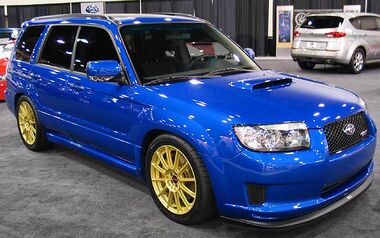
In 2004, Subaru launched the Forester STI for the Japanese Market only. A "sportier" version of the standard second-gen (SG) Forester, the Forester STi incorporated most of the running components from the WRX STi, with several other changes. The base price for the Forester STi (new) was about ¥3,000,000 in 2005 or about US$28,000 (equivalent to $37,103 in 2020)[11] The Forester STi has AWD and a front-mounted engine. The Forester STi was never exported to any other markets. It was only distributed in Japan.
The Forester STi exterior was modified with additions such as a redesigned front fascia with new headlights, front bumper, grille and "STi" badged covered fog lights, like those seen on the Impreza WRX STi. The rear fascia was also redesigned with revised taillights, a revised rear bumper, and an added rear spoiler. The Forester STi received the 2.5-liter turbocharged flat-four from the WRX STi, making 265 PS (195 kW) and 186.0 lb-ft of torque. A six-speed manual gearbox, a larger intercooler, and a low-back-pressure exhaust system were also added. The top three ratios of the gearbox are 14 percent taller to match the engine's torque curve.
To cope with the extra power made by the new engine, the Forester STi got many upgraded suspension components including STi sport springs, revised struts at each corner, and bigger anti-roll bars and cross-members. These changes resulted in a 1.2 inch lower ride height and improved resistance to torsional forces. Rolling resistance was also improved, but the higher center of gravity of the Forester still remained. The 2006 Forester STi accelerates from 0-60 (0-96.6 kph) mph in 5.2 seconds, 0-62 mph (0-100 kph) in 5.4 seconds, and does the quarter mile in 14.1 seconds @ 97.0 mph (156.11 kph). The Forester STi can go on to reach a top speed of 140 mph (225.3 kph) The Forester STi has a power to weight ratio of 174 hp per ton.
First Generation (SF; 1997)[]
The Forester was introduced at the Tokyo Motor Show in November 1995 as the Streega concept, and available for sale in February 1997 in Japan, and to the US market in 1997 for MY1998. The Forester was one of the first emerging crossover SUVs. It was built in the style of a car, but had a taller stance, higher h-point seating, and an all-wheel drive drivetrain. Subaru advertising employed the slogan "SUV tough, Car Easy". It used the Impreza platform but with the larger 2.5-liter DOHC EJ25D four-cylinder boxer engine from the Subaru Outback, making 123 kW (165 hp; 167 PS) at 5,600 rpm and 220 N⋅m (162 lb⋅ft) of torque at 4,000 rpm. In its domestic market the Forester replaced the Subaru Impreza Gravel Express, known in the US as the Subaru Outback Sport. However, the Outback Sport remained in production for the U.S. market. The Forester appeared after the introduction of the Nissan Rasheen in Japan with a similar appearance, and the Forester's Japanese competitors include the Toyota RAV4, Mitsubishi RVR, and the Suzuki Grand Vitara. Due to the Forester's low center of gravity, it meets the United States federal safety standards for passenger vehicles and does not require a "risk of rollover" warning label on the driver's visor. Size- and price-wise, it fits between the shared Impreza platform and the larger Legacy. The automatic transmissions used on AWD-equipped vehicles will normally send 60% of the engine's torque to the front wheels and 40% to the rear wheels, using a computer-controlled, continuously variable, multi-plate transfer clutch. When the transmission detects a speed difference between the front and rear axle sets, the transmission progressively sends power to the rear wheels. Under slip conditions, it can achieve an equal split in front and rear axle speeds. When accelerating or driving uphill, the vehicle's weight shifts rearward, reducing front-wheel traction, causing the transmission to automatically send torque to the rear wheels to compensate. When braking or driving downhill, the vehicle's weight shifts towards the front, reducing rear-wheel traction. The transmission again compensates by sending torque to the front wheels for better steering control and braking performance. If the automatic is placed in reverse or first gear, the transmission divides the torque 50/50 to both front and rear wheels. The manual transmission cars are set up with a near 50/50 torque split as a base setting, and it varies from there. Essentially, manual cars are set up with more bias towards the rear than automatic cars.
Worldwide[]
Up until recently, the Forester was also sold in India as a Chevrolet alongside other Chevrolet models sold there. This model featured a naturally aspirated 2.0 L flat-4 engine rated at 120hp. However, since General Motors no longer holds an ownership stake in Subaru's parent company, Fuji Heavy Industries, this arrangement is in question.
Australia[]
The Forester has three main models available in Australia:
- X - naturally-aspirated 2.5 L flat-4, 121 kW (162 hp)
- XS - naturally-aspirated 2.5 L flat-4, 121 kW (162 hp)
- XT - turbocharged 2.5 L flat-4, 169 kW (226 hp)
The difference between the X and the XS is the styling of the car through its accessories. Both the XS and the XT come with the option of having a "Luxury Pack" fitted - allowing for leather seats and a sunroof. Besides the difference in engine between the X or XS when compared to the XT, there are other minor styling differences like the addition of a MOMO steering wheel as standard on the XT model.
Currently, the Forester is Australia's best-selling SUV.
Design quirks and oddities[]
According to the Australian Used Car Safety Rating, the 1997-2002 Subaru Forester is the safest car which has the highest crash protection and the lowest aggressivity.UCSR Results for 1997-2002 Subaru Forester.
According to the What Women Want survey conducted by the RACV in 2003, the Forester is the most popular choice amongst women buying a Subaru.
Awards[]
- Winner Australia's Best Recreational Four Wheel Drive in 2000
- Winner Australia's Best Recreational Four Wheel Drive in 2001
- Winner Australia's Best Recreational Four Wheel Drive in 2002
- Winner Australia's Best Recreational Four Wheel Drive in 2006
- Car and Driver's Best Small SUV 2004
- Car and Driver's Best Small SUV 2005
- Car and Driver's Best Small SUV 2006
- 2009 Carsales Compact SUV People's Choice AwardReferences
See also[]
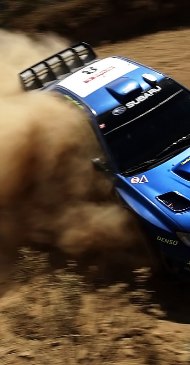
| ||
| SUBARU | ||
|
Fuji Heavy Industries Current: Impreza WRX · Impreza WRX STI · Legacy · Outback · Forester · B9 Tribeca · R1 · R2 · Pleo · Sambar · Justy · Exiga · Dex · Trezia · BRZ Historic: Alcyone SVX / XT · 360 · FF-1 Star · FF-1 G · 1400 DL/GL · 1600 Leone · 1800 · Alcyone · Subaru 22B STi · BRAT · Brumby · Baja · Leone · GL/DL/Loyale · Rex · Traviq · Vivio Racing: Impreza WRC · Legacy B4 GT300 Concept: Elten Custom · Fleet-X · HM-01 · WX-01 · B9 Scrambler · R1e · R2 · B11S · B5-TPH · Impreza WRC Concept · G4e Concept · Impreza Exiga Concept · STELLA Concept · Impreza WRX STI Takumi Concept · Forester XTI Concept · Forester Mountain Rescue Vehicle Concept · Legacy Concept · Hybrid Tourer Concept · Impreza Concept Subaru Tecnica International · Engines | ||
| Chikuhei Nakajima | Corporate website | A subsidiary of Fuji Heavy Industries |
External links[]
- Mainely Subarus Maine Subaru Enthusiast Car Club
- Official Subaru Forester Homepage and Next-Gen Countdown jp
- The Subaru Forester Owners Forum
- JB car pages: Subaru Forester
- Offroad Subarus (take your Subaru, including Forester, off-road)
- Chevrolet Forester (India)
- Subaru Forester 2.5 XT Review
- 2009 Subaru Forester Unveiled
- The 2009 Subaru Foresters That Never Were: Ditched Designs
- 2009 Subaru Forester: US Spec Version Image Gallery
- Photo Gallery of 2011 Subaru Forester with New Grille and 2.5L Boxer

|
This page uses some content from Wikipedia. The original article was at Subaru Forester. The list of authors can be seen in the page history. As with Autopedia, the text of Wikipedia is available under the GNU Free Documentation License. |
